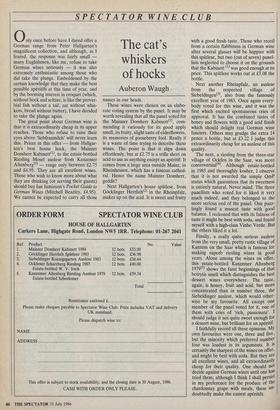SPECTATOR WINE.CLUB
The cat's whiskers of hocks
Auberon Waugh
The great point about German wine is that it is extraordinarily cheap in its upper reaches. Those who refuse to raise their eyes above liebfraumilch' will never learn this. Prices in this offer — from Hallgar- ten's best house hock, the Mainzer Domherr Kabinett(1), to the estate-bottled Riesling Mosel auslese from Kanzemer Altenberg(5) — range only between £2.75 and £4.95. They are all excellent wines. Those who wish to know more about what they are drinking (or serving their guests) should buy Ian Jamieson's Pocket Guide to German Wines (Mitchell Beazley, £4.95). We cannot be expected to carry all those
names in our heads.
These wines were chosen on an elabo- rate voting system by the panel. It may be worth revealing that all the panel voted for the Mainzer Domherr Kabinett(1), com- mending it variously for its good apply smell, its fruity, slight taste of elderflowers, its memories of gooseberry fool. Really it is a waste of time trying to describe these wines. The point is that it slips down effortlessly, but at £2.75 is a trifle short on acid to use as anything except an aperitif. It comes from a large area outside Mainz, in Rheinhessen, which has a famous cathed- ral. Hence the name Mainzer Domherr, geddit?
Next Hallgarten's house spatlese, from Gocklinger Herrlich(2) in the Rheinpfalz, makes up on the acid. It is sweet and fruity with a good fresh taste. Those who recoil from a certain flabbiness in German wine after several glasses will be happier with this spatlese, but two (out of seven) panel- lists neglected to choose it on the grounds that the Kabinett (I) was good enough at its price. This spatlese works out at £3.08 the bottle.
• Next another Rheinpfalz, an auslese from the respected village of Siebeldingen(3), also from the famously excellent year of 1983. Once again every- body voted for this wine, and it was the first which excited spontaneous cries of approval. It has the combined tastes of honey and flowers with a good acid finish which should delight real German wine fanCiers. Others may grudge the extra 14 pence a bottle, but at £3.22 I judge this extraordinarily cheap for an auslese of this quality.
The next, a riesling from the three-star village of Ockfen in the Saar, was more controversial141. Although estate-bottled in 1985 and thoroughly kosher, I observe that it is not awarded the simple QmP status which guarantees that its sweetness is entirely natural. Never mind. The three panellists who voted for it liked it very much indeed, and they belonged to the more serious end of the panel. One puzz- lingly found a muscat taste with good balance. I reckoned that with its fulness of taste it might be best with soda, and found myself with a high-class Vinho Verde. But the others liked it a lot.
Finally, a really quite serious auslese from the very small, pretty rustic village of Kanzem on the Saar which is famous for making superb riesling wines in good years. Alone among the wines on offer, this estate-bottled Kanzemer Altenberg 197901 shows the faint beginnings of that botrytis smell which distinguishes the best dessert wines everywhere. The taste, again, is honey, fruit and acid, but more concentrated than in number three, the Siebeldinger auslese, which would other- wise be my favourite. All except one member of the panel voted for it, one of them with cries of 'rich, passionate'. I should judge it not quite sweet enough for a dessert wine, but brilliant for an aperitif. I faithfully record all these opinions. MY own favourites were one, three and five, but the minority which preferred number four was loudest in its arguments. It is certainly the sharpest of the wines on offer, and might be best with soda. But they are all excellent wines, and all extraordinarilY cheap for their quality. One should not decide against German wines until one has tried them; although I think I shall persist in my preference for the produce of the chardonnay grape with meals, these un- doubtedly make the easiest apéritifs.


















































 Previous page
Previous page